Blog
Dance Leortard - The History

The Leotard was named after its creator, Jules Léotard (August 1, 1838 – August 16, 1870).
 Leotard was a French acrobat who specialised in aerials and was also the one who developed the art of trapeze. Due to his involvement in acrobatics, he created and popularised the one-piece gymnastics leotard that today bears his name (Leotard).
Leotard was a French acrobat who specialised in aerials and was also the one who developed the art of trapeze. Due to his involvement in acrobatics, he created and popularised the one-piece gymnastics leotard that today bears his name (Leotard).
It is a one-piece garment that hugs the body tightly and covers the torso from the crotch to the shoulder, but due to the elasticity of the fabric, it does not cause discomfort.
There are various forms with different sleeve lengths. From the "camisole" leotard which has a very thin strap, to long-sleeved three- or four-quarter-length leotards.
A variation is the one-piece leotard (unitard), which also covers the legs. It provides style and modesty to the performer, while allowing freedom of movement with its elasticity, depending of course on the material from which it is made.
Leotards are worn by acrobats, gymnasts, dancers, figure skaters, athletes, actors, wrestlers and circus performers both as training clothes and as performance costumes. They are often worn with ballet tutus over them and tights or sometimes with cycling shorts as underwear. At the same time, it can be worn as everyday clothing.
Meryl: The Finest of Fabrics

MERYL® FIBER
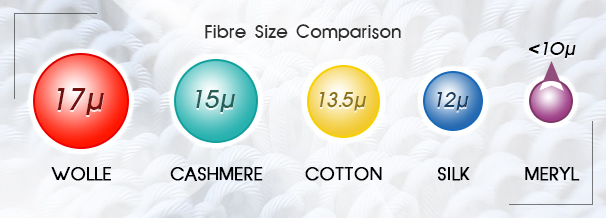 Microfibre is a generic term for a non natural ultra fine fiber (polyamide) finer than silk. Fabrics made with microfibres are soft, lightweight, breathable and durable. Meryl® Microfibre is made up of big quantities of thin fibres. In usual tights, the polyamide yarn consists of 2 - 8 fibres, in micro - (multi) fibre there are from 17 up to 52 fibres with the same thickness of a fibre.
Microfibre is a generic term for a non natural ultra fine fiber (polyamide) finer than silk. Fabrics made with microfibres are soft, lightweight, breathable and durable. Meryl® Microfibre is made up of big quantities of thin fibres. In usual tights, the polyamide yarn consists of 2 - 8 fibres, in micro - (multi) fibre there are from 17 up to 52 fibres with the same thickness of a fibre.
Microfibre is available in acrylic, nylon, polyester, and rayon. When woven the product is an extremely drapeable, very soft and luxurious fabric.
Thanks to the fineness of each filament (less than 10μ), this well known Nylstar speciality makes possible the construction of very fine close woven and knitted fabrics, characterised by soft handle, breathability and resistance to wind and rain.
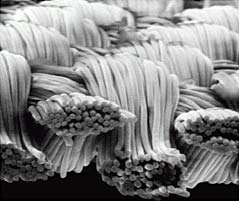 Ideal for light garments, with direct contact to the skin, it finds its own natural application in stockings, socks and lingerie.
Ideal for light garments, with direct contact to the skin, it finds its own natural application in stockings, socks and lingerie.
Meryl actisytem fabric has the superior performance benefits of modern fibre technology with an exceptionally soft handle combined with the durability and robustness of nylon.
It stretches 5 times in length with full recovery to give enhanced fit and performance characteristics including four-way stretch. It is fully breathable and its moisture management performance keeps you cool and dry. Light and windproof, Meryl / Lycra® also dries quickly.
The comfort and stretch of this fabric cannot be beaten and it offers excellent protection to UVA and UVB rays from exposure to sunlight. To top this off Meryl keeps its vibrant colour and softness, wash, after wash, after wash.
What is LYCRA® fiber

LYCRA® FIBER
Since its invention over sixty years ago, LYCRA® fiber set the standard as the world’s best-known spandex fiber brand. Lightweight and nearly invisible, LYCRA® fiber became the active ingredient in our clothes and revolutionized the way we wore them. Whenever it’s used in fabrics, LYCRA® fiber transforms garments into better fitting, durable clothes that move with our bodies, delivering fit, shape and comfort that lasts. Day after day. Wash after wash. Run after run. Swim after swim.
Why choose LYCRA® fiber?
The LYCRA® brand has over 60 years’ experience innovating unique fibers for the clothes you love to wear.
In that time, LYCRA® fiber has become renowned for its quality and durability, and has become the most recognized brand of spandex fiber in the world today. People choose it for its exceptional elasticity, lasting shape, and the comfortable fit it delivers to all types of apparel.
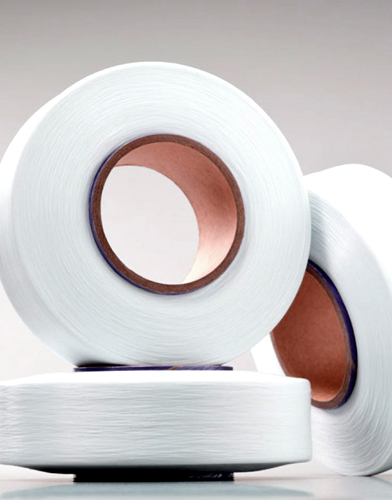 Where is LYCRA® used?
Where is LYCRA® used?
This fiber adds lasting comfort, fit and shape to virtually every type of apparel -from underwear to outerwear- and it even has non-apparel uses too. Normally and more commonly you will find it in:
- hosiery,
- jeans,
- lingerie,
- pants,
- shapewear,
- shirts,
- socks,
- sportswear and activewear,
- swimwear,
- underwear.
Lycra is almost always mixed with another fabric -even the stretchiest leotards and bathing suits are less than 40% Lycra mixed with cotton or polyester. Due to its ability to mold to the body, Lycra is ideal for compression garments, surgical stockings, swimwear and sportswear. It's also used to add stretch to jeans, tops, dresses and even fitted sheets.
So what is Lycra as a Fiber?
Also known as Spandex, Lycra is a fully synthetic fiber that has become highly popular throughout the world. It is a highly synthetic elastic polymer based on the polyurethane composition found in many plastic polymers.
Despite the different names, this fabric can stretch 5 to 8 times its usual size. Lycra is a brand name for Spandex, and is heat resistant to a great extent, making it a suitable addition to heat-sensitive synthetic fabrics such as polyester and nylon.
Composition of Lycra
As mentioned above, Lycra is a synthetic polymer, composed of long chains of monomers. These monomers are connected with a special kind of acid, and polyurethane makes it heat resistant and imparts elasticity. All the components of Lycra are composed in the laboratory with some organic components synthesized over and over to an extent that they lose their organic composition.
Methods used in Lycra production
There are four ways to manufacture Lycra with one being the major constituent of total Lycra production around the world. The methods used are: solution wet spinning, solution dry spinning, reaction spinning, and melt extrusion.
Solution dry spinning contributes 95% share to the global Lycra production. Most of these methods are entirely discarded due to production costs, quality standards, and environmental impact.
Cotton - Elastane
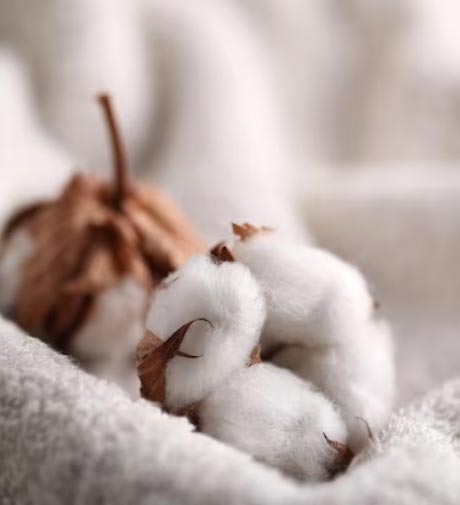
ELASTANE:SPANDEX - LYCRA
Nowadays, there are plenty of fabrics on the market, but elastane is one of the most common ones. We bet everyone has at least one item that contains this material, that’s why we decided to get you more acquainted with it.
So, briefly, what is elastane? Elastane is a term for an incredibly elastic synthetic fiber also called “spandex” and “lycra”. It is made from polyether-polyurea fiber copolymer and was invented by Duponts company. Manufactures widely use it to combine it with other fabrics, for example, with wool, to bring more elasticity to it.
Ready to explore? Then off we go!
What fabric is elastane?
Elastane (can be called “spandex” and “lycra”) is a synthetic polyurethane fabric that is similar in its main characteristics to rubber.
Suppose we are talking about elastane and its properties, in that case, we have to mention that today it is rarely used in its pure form – exclusively in combination with other varieties of synthetic and natural fibers(with cotton, polyester, and much more).
It is usually included as a part of viscose, cotton, silk, or knitwear garment, which improves their characteristics.
It was produced in the 50s of the last century in the United States. After that, polyurethane threads began to be actively produced in European and Asian countries.
The history of elastane
The material was invented in the 1950s by the American chemist J. Shivers in Delaware State.
This scientist was an employee of the DuPont company, which manufactures synthetic materials (nylon, teflon, kevlar).
For a long time, Shivers studied thermoplastic elastomer, which, when heated, became stretchy and became plastic. As a result, elastane was created, and the company starts to make durable fabric with a density of no more than 1.3 g / cc. cm.
Initially, the material was used to produce corsets, and in the 1960s – for sewing sportswear.
Soon, the fabric gained popularity, they began to make everyday wardrobe items from it, and then festive ones.
How to call elastane correctly?
Lycra, spandex linel, dorastan, and elastane are all fabrics made from polyurethane but produced by different companies. You cannot say that these are some radically different materials, these are brands, brands of fibers.
For example, many types of elastane are called lycra. Invista, the brand owner, defends its trademark and emphasizes that elastane should not be called lycra. For comparison, Dolce & Gabbana clothes cannot be called “Chanel”, although their properties may be similar.
In the US , the word “spandex” is used to name elastane, which we get as a result of rearranging the letters in the word “expand”. Sometimes in the US, we use a synonym for this word – “vairin”. In Europe, the name “lycra” is widespread.
Briefly:
What is elastane made of ?
Elastane fibers are segments that are interconnected by elastic “bridges” – such type a connection does not allow the fabric to tear during stretching and wearing.
When you use a microscope, the structure of the material looks porous and airy.
Polyurethane elastane fibers can be produced in several ways:
- the raw material melts and passed through extruders – molds
- obtained by chemical formation
- formed from dry or wet raw materials using appropriate production methods
The result is a soft, smooth, silky and cool fabric that wraps around the skin like water.
Elastane can be dyed in absolutely any color, filled with a pattern, or left unicolored.
How to use elastane fabric?
Bright stretchy things attract us with their unusual appearance and versatility.
For example, elastane turtlenecks can be bought without trying on – you should only remember desired sleeve length.
Elastane is also suitable for people who save their time and prefer not to iron their clothes.
Even those rare wrinkles on your favorite dress will disappear quickly when you wear your clothes on. And that why we are in love with elastane.
Elastane can be used for:
- casual clothes (leggings, turtlenecks, dresses);
- tracksuits (pants, jackets, T-shirts, T-shirts);
- stage, variety, carnival costumes;
- linen;
- socks.
Elastane is a smooth and shiny fabric. Clothes that are made from it look smart, festive, and modern.
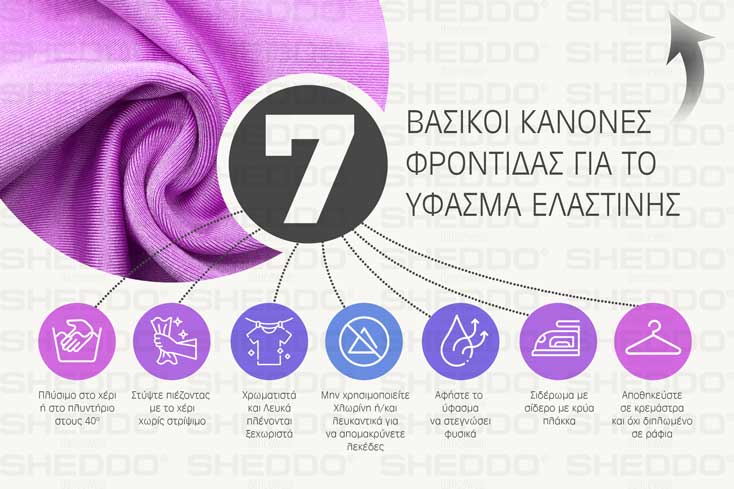 7 Main care rules for elastane fabric
7 Main care rules for elastane fabric
The first and foremost idea is always – check the label first before
washing your favourite clothes made from elastane or any other fabric.
- gentle hand wash or you can use a washing machine at 104 degrees
- wring out by hand, without twisting
- colored and white items should be washed separately
- do not use aggressive bleaches and stain removers
- dried naturally, away from heating appliances, or prefer dry flat
- should be ironed with a non-hot iron
- it is better to store clothes made of elastane folded than on the hangers, the clothes can irreversibly stretch
How It Is Produced
To begin with, we need to admit that elastane is a general term used for fabrics or yarns that can be easily stretched. Elastane fibers are man-made and they are always used in conjunction with other fibers but never alone.
To be precise, elastane consists of polyurethane (that is very stretchy) and polyethylene glycol, and due to such content, elastane can achieve a total elongation of more than 700%!
When compared to other popular fabrics like polyester, cotton, and nylon, the elastane has certain significant distinctions that are good to know to be able to choose the proper item in a store.
- Unlike elastane, polyester is way more sturdy and it can not stretch. Another issue about polyester is that it is very predisposed to holding on to the body odor – a problem that elastane has not. In addition, this fabric tends to be way more wear-resistant which means it won’t stretch over time as elastane does.
- As for nylon vs polyester issue, nylon is quite stretchy compared to its counterpart, and it’s known for being strong, and abrasion-resistant. This fabric is very easy to maintain and the fabric itself is very pleasant to the touch, soft and light.
- Soft and breathable cotton is somewhat different on the other hand, that’s why we often find it difficult to choose between cotton or polyester. This material is natural, so it is more absorbent but at the same time strong and abrasion and heat-resistant.
| FABRIC | Absorbency | Moisture-wicking | Skin-friendly | Nature-friendly |
|---|---|---|---|---|
| Cotton | Good | High | Excellent | Good |
| Elastane | Poor | Poor | Poor (allergic reactions are possible) | Fair |
| Polyester | Poor | Poor | Poor (skin allergy is possible) | Fair |
| Nylon | Poor | Poor | Poor (the risk of allergy on sensitive skin) | Fair |
Different types of elastane fabric
The elastane (spandex, lycra) has a lot of varieties.
Any polyurethane fabrics can be differentiated in this way.
Here are types of elastane based on their stretchability:
- two-dimensional – in this case, the elastane stretches in one direction, usually in wide;
- four-dimensional – this kind of fabric has improved stretchability – it stretches both in length and width. This property allows the fabric to be used in sports equipment.
Elastane can be mixed with these fabrics
- Cotton stretch – this name hides a fabric where cotton and elastane are combined. The elastane component can be insignificant – up to 3% and higher – 15 – 20%. This material has improved characteristics and is superior in properties, so it is better than pure elastane and pure cotton;
- Polyester – this fabric contains polyester (85 – 95%) and elastane (5 – 15%). Polyester fabric itself is synthetic, just like lycra. But if cotton or linen is added, then the fabric turns out to be more comfortable and pleasant to the body;
- Nylon – in fact, it is a combination of polyamide and elastane. The fabric is lightweight, dense and waterproof. It is used mainly for sewing outerwear;
- Polyviscose – is a fabric based on viscose and polyester with a small addition of cotton and elastane. If there is more cotton at the base of the thread, then it would be poly-cotton;
- Poly-wool – a blended fabric based on wool and elastane, sometimes containing viscose and polyester. A feature of all mixed materials with the addition of lycra is the gives your sweater high elastisity.
- Crepe – fabric with a high twist of the threads, it is also called crepe. The fabric is easy to identify by its appearance – the front side is smooth and the inside is matte. Crepe twist fabrics with a beautiful drape are suitable for making casual and smart clothes.
The main advantages of elastane
- Elasticity. Spandex stretches well and can grow up to eight times its length. Moreover, after stretching, it easily and quickly returns to its original shape.
- Strength and wear resistance. Adding spandex to the garment doubles its lifespan.
- Density. Can reach 1.3 g / cc. This creates a stretch effect: outfits containing elastane fits the figure beautifully.
- It is very light.
- Softness. Mixed fabric can be draped without problems.
- Subtlety. These synthetics can be added to any other fabrics: it will be woven easily.
- Breathability: the body “breathes”.
- Water resistance.
- Comfort to wear. Things with spandex do not bind the body, do not wrinkle, and do not shrink.
- Resistant to dirt. Almost any stain can be washed off with a simple rinse.
The main disadvantages of elastane
- It is a synthetic fiber.
- Spandex can cause allergic reactions.
- Intolerance to prolonged exposure to direct sunlight.
Measurements & Size Selection
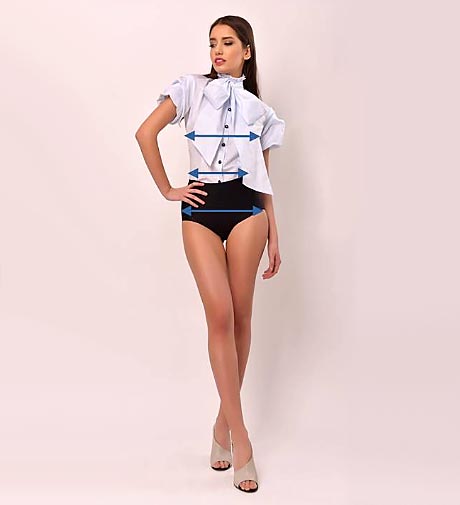
Measurements Guidelines
An appropriate choice of size is necessary to feel perfectly at ease in your garment. Please take the measurements loosely, directly on your body. If in doubt, always choose the biggest size.
► Click here to see the diagram ◄
- Height: Full height (bare feet).
- Girth: Measure from the center of one shoulder, down the front through crotch and up the back to starting point. (Slantwise).
- Bust: With arms relaxed down at sides, loosely measure around the fullest part of chest, keeping tape measure parallel to the floor.
- Waist: Measure around natural waistline, the narrowest part of the upper body (not over shirt or pants).
- Low Waist: Loosely, at the upper part of hip / low waist.
- Hips: Measure around fullest part of the lower body, keeping tape straight and parallel to the floor. At the widest place (lower hip).
- Inseam (for pants & Unitards): Measure inside of leg, from crotch to just below the ankle bone.
- For Character & Flamenco skirts waist, hips, length must be measured.
SELECTION OF SIZE
FEMALE BODYWEAR
| Skirt Size | Sizes | Bust | Waist | Hips | Girth ½ |
|---|---|---|---|---|---|
| XS | 78-90 | 60-70 | 86-95 | 66-75 | |
| 42 | S | 84-95 | 64-75 | 90-100 | 68-78 |
| 44 | M | 88-100 | 68-80 | 95-105 | 74-84 |
| 46 | L | 92-105 | 72-85 | 98-110 | 77-87 |
| 48 | XL | 96-112 | 76-90 | 105-116 | 83-95 |
CHILDREN'S BODYWEAR
| Skirt Sizes | Sizes | Height | Bust | Waist | Hips | Girth ½ |
|---|---|---|---|---|---|---|
| 6 | XXS - 4 ANS | 100-114 | 48-54 | 46-52 | 50-56 | 48-52 |
| XS - 6 ANS | 116-120 | 48-56 | 48-56 | 54-62 | 50-54 | |
| 8 | S - 7 ANS | 118-126 | 54-64 | 50-60 | 58-68 | 52-56 |
| M - 8 ANS | 124-134 | 58-70 | 52-64 | 62-74 | 53-57 | |
| 10 | L - 10 ANS | 132-142 | 60-74 | 55-68 | 65-78 | 56-61 |
| 12 | XL - 12 ANS | 140-150 | 66-80 | 58-72 | 70-84 | 58-63 |
| 14 | XXL - 14 ANS | 145-156 | 75-90 | 64-80 | 78-94 | 61-66 |
FEMALE TIGHTS
| Sizes | Age | Height | Weight |
|---|---|---|---|
| S | AB | 140-150 | 40-50 |
| M | 151-160 | 50-60 | |
| L | CD | 161-170 | 60-70 |
| XL | 171-190 | 70-80 |
CHILDREN'S TIGHTS
| Sizes | Age | Height | Weight |
|---|---|---|---|
| 000 | 4-6 | 90-110 | 25-30 |
| 00 | 6-8 | 110-125 | 30-35 |
| 0 | 8-10 | 125-140 | 35-40 |
Page 1 of 2



